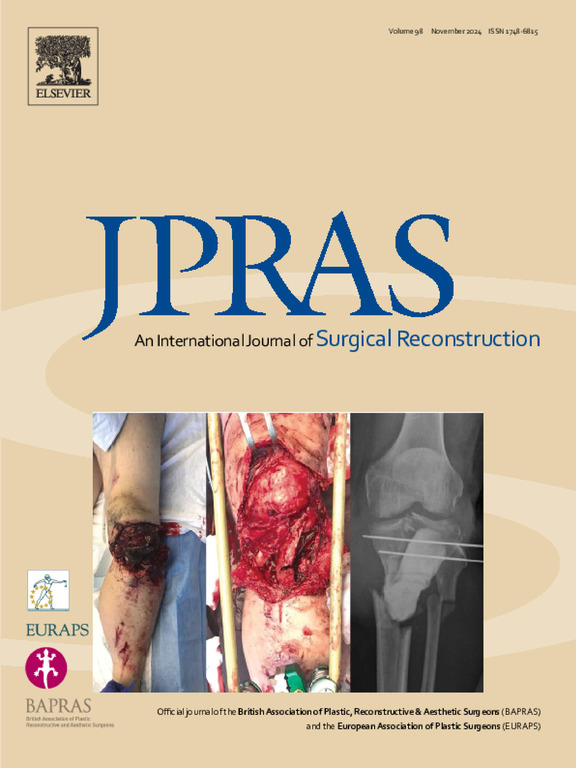Immediate lymphatic reconstruction for prevention of secondary lymphedema in cancer patients: A meta-analysis of 42 studies
IF 2.4
3区 医学
Q2 SURGERY
Journal of Plastic Reconstructive and Aesthetic Surgery
Pub Date : 2025-07-07
DOI:10.1016/j.bjps.2025.06.038
引用次数: 0
Abstract
Background
Secondary lymphedema, a common complication following lymph node dissection, affecting up to 53% of cancer survivors, imposes significant morbidity and reduced quality of life. Immediate lymphatic reconstruction (ILR) has emerged as a preventive strategy; however, its efficacy remains unclear.
Methods
We conducted a PRISMA/AMSTAR-compliant systematic review and meta-analysis. A comprehensive search of PubMed, EMBASE, and Web of Science (2009–2024) identified studies evaluating ILR for lymphedema prevention. Random-effects models were used to calculate pooled odds ratios (ORs) for comparative studies and pooled incidence proportions for single-arm studies, each with 95% confidence intervals (CIs). Subgroup analyses examined extremity site, follow-up duration, BMI, and study design. Publication bias was assessed with funnel plots and Egger’s test.
Results
We included 42 studies with a total of 4539 patients. Among comparative studies, ILR was associated with roughly a 75% reduction in lymphedema risk (pooled OR = 0.25, 95% CI 0.17–0.36, p=0.004). A temporal decline in ILR’s protective effect was observed: OR 0.11 at <1 year follow-up versus OR 0.41 at ≥2 years (p=0.003). Across 19 single-arm studies, the pooled lymphedema incidence after ILR was 7.34% (95% CI 4.97–10.71%), rising to ∼20% in studies with >2 years of follow-up. Heterogeneity among studies was moderate (I² = 51%). Funnel plots indicated potential publication bias in comparative studies (Egger’s test: z=−2.14, p=0.032), but not in single-arm studies (p=0.105).
Conclusion
ILR reduces the risk of cancer-related secondary lymphedema, particularly for breast cancer patients in the early postoperative period. Standardized surgical protocols and prolonged follow-up are needed to optimize and confirm long-term benefits.
立即淋巴重建预防癌症患者继发性淋巴水肿:42项研究的荟萃分析
继发性淋巴水肿是淋巴结清扫后的常见并发症,影响了高达53%的癌症幸存者,造成了显著的发病率和生活质量下降。立即淋巴重建(ILR)已成为一种预防策略;然而,其功效尚不清楚。方法我们进行了符合PRISMA/ amstar标准的系统评价和荟萃分析。对PubMed、EMBASE和Web of Science(2009-2024)的综合检索确定了评估ILR预防淋巴水肿的研究。随机效应模型用于计算比较研究的合并优势比(or)和单组研究的合并发生率,每个模型都有95%的置信区间(ci)。亚组分析检查了肢体部位、随访时间、BMI和研究设计。采用漏斗图和Egger检验评估发表偏倚。结果纳入42项研究,共4539例患者。在比较研究中,ILR与淋巴水肿风险降低约75%相关(合并OR = 0.25, 95% CI 0.17-0.36, p=0.004)。观察到ILR保护作用的时间下降:随访1年时OR为0.11,而随访≥2年时OR为0.41 (p=0.003)。在19项单臂研究中,ILR后淋巴水肿的总发生率为7.34% (95% CI 4.97-10.71%),在随访2年的研究中上升至20%。研究间异质性为中等(I²= 51%)。漏斗图显示比较研究中潜在的发表偏倚(Egger检验:z= - 2.14, p=0.032),但单组研究中没有(p=0.105)。结论ilr可降低乳腺癌术后早期继发性淋巴水肿的发生风险。需要标准化的手术方案和长期随访来优化和确认长期效益。
本文章由计算机程序翻译,如有差异,请以英文原文为准。
求助全文
约1分钟内获得全文
求助全文
来源期刊
CiteScore
3.10
自引率
11.10%
发文量
578
审稿时长
3.5 months
期刊介绍:
JPRAS An International Journal of Surgical Reconstruction is one of the world''s leading international journals, covering all the reconstructive and aesthetic aspects of plastic surgery.
The journal presents the latest surgical procedures with audit and outcome studies of new and established techniques in plastic surgery including: cleft lip and palate and other heads and neck surgery, hand surgery, lower limb trauma, burns, skin cancer, breast surgery and aesthetic surgery.

 求助内容:
求助内容: 应助结果提醒方式:
应助结果提醒方式:


